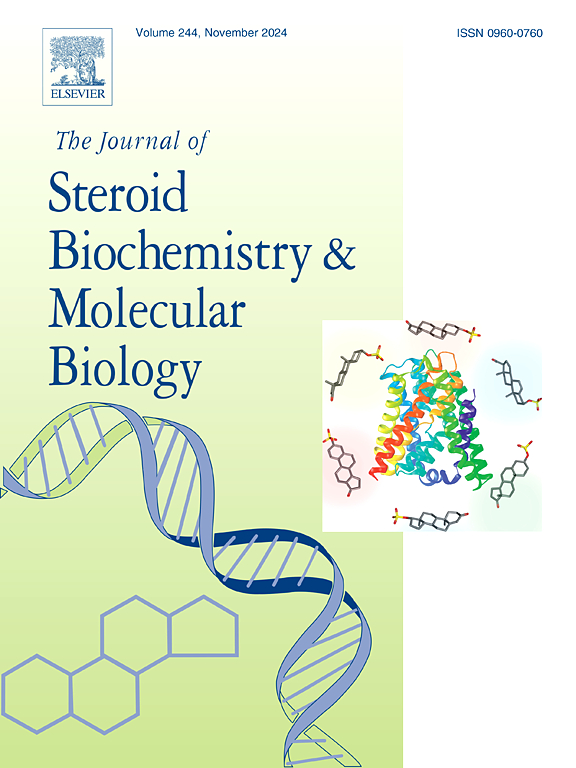服用高效CFTR调节剂治疗的囊性纤维化青年患者的维生素D状况
IF 2.5
2区 生物学
Q3 BIOCHEMISTRY & MOLECULAR BIOLOGY
Journal of Steroid Biochemistry and Molecular Biology
Pub Date : 2025-06-06
DOI:10.1016/j.jsbmb.2025.106810
引用次数: 0
摘要
由于脂溶性维生素吸收不良,维生素D缺乏是囊性纤维化(PwCF)患者的常见病理。维生素D在骨骼健康和肺部免疫中起着不可或缺的作用;因此,治疗缺陷是PwCF的临床重点。高效调节疗法(HEMT)改善了在PwCF中改变的囊性纤维化跨膜传导调节(CFTR)蛋白的功能,从而改善肺功能和脂肪吸收。然而,HEMT对恢复维生素D状态(一种脂溶性维生素)的影响尚未完全阐明。我们回顾性地检查了89例CF年轻成人患者10年前的血清25-羟基维生素D (25(OH)D),这些患者根据目前是否使用HEMT进行分类(是或否)。我们使用双向方差分析来评估两组的趋势。HEMT使用者(n=68)和非HEMT使用者(n=21)在10年内平均表现出血清25(OH)D水平下降(分别为-14.2ng/mL (SI 35.4 nmol/L)和-14ng/mL (SI 34.9 nmol/L),两组之间无差异变化(p=0.44)。这表明HEMT可能不能纠正PwCF中的维生素D状态。需要进一步大规模的前瞻性研究来全面研究维生素D与HEMT之间的关系。本文章由计算机程序翻译,如有差异,请以英文原文为准。
Vitamin D status in young adults with cystic fibrosis on highly effective CFTR modulator therapy
Vitamin D deficiency is a common pathology in people with cystic fibrosis (PwCF) due to the malabsorption of fat-soluble vitamins. Vitamin D plays an integral role in bone health and lung immunity; therefore, treating deficiencies is a clinical priority in PwCF. Highly effective modulator therapy (HEMT) improves the function of the cystic fibrosis transmembrane conductance regulator (CFTR) protein that is altered in PwCF, resulting in improved lung function and fat absorption. However, the impact of HEMT on restoring vitamin D status, a fat-soluble vitamin, has not been fully elucidated. We retrospectively examined serum 25-hydroxyvitamin D (25(OH)D) up to ten years prior in 89 young adults with CF classified based on current HEMT use (yes or no). We used two-way ANOVA to evaluate trends in both groups. Both HEMT users (n = 68) and HEMT non-users (n = 21) on average exhibited decreased serum 25(OH)D levels over ten years (-14.2 ng/mL (SI 35.4 nmol/L) and −14 ng/mL (SI 34.9 nmol/L) respectively), with no difference in change between the two groups (p = 0.44). This suggests that HEMT may not correct vitamin D status in PwCF. Further large scale prospective studies are needed to comprehensively investigate the relationship between vitamin D and HEMT.
求助全文
通过发布文献求助,成功后即可免费获取论文全文。
去求助
来源期刊
CiteScore
8.60
自引率
2.40%
发文量
113
审稿时长
46 days
期刊介绍:
The Journal of Steroid Biochemistry and Molecular Biology is devoted to new experimental and theoretical developments in areas related to steroids including vitamin D, lipids and their metabolomics. The Journal publishes a variety of contributions, including original articles, general and focused reviews, and rapid communications (brief articles of particular interest and clear novelty). Selected cutting-edge topics will be addressed in Special Issues managed by Guest Editors. Special Issues will contain both commissioned reviews and original research papers to provide comprehensive coverage of specific topics, and all submissions will undergo rigorous peer-review prior to publication.

 求助内容:
求助内容: 应助结果提醒方式:
应助结果提醒方式:


